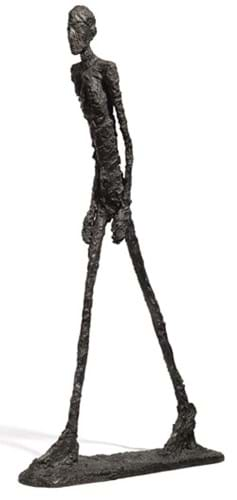But what was so special about it?
While prices for the Swiss sculptor rose strongly during the decade-long art market boom which finally crashed in October 2008, this bronze was different from anything that had been offered before.
L'Homme qui Marche is considered Giacometti's most iconic figure - the first time he experimented with the theme of the walking man on a monumental scale.
But, crucially, this 6ft (1.83m) high bronze was a lifetime cast and represented a buying opportunity that may never come again.
It is one of only six casts made by the sculptor in 1961. Three others are in public collections and the other two are said to be unlikely to appear on the market in the foreseeable future.
The record-breaking sculpture came to Sotheby's from the Dresdner Bank in Germany, which is selling or loaning out 100 works from its corporate collection as part of a "general reorganisation of the company".
Yet, even if most people expected it to set a substantial new artist's record for Giacometti, it is difficult to believe that there was anyone present that night who was not staggered by the final £58m hammer price.
With the estimate at £12m-18m, the most optimistic prediction flying around in the packed saleroom beforehand was around £40m - which in any case would have been a huge jump from the previous Giacometti high of $24.5m (£12.4m) seen for Grande Femme Debout II, sold to the Gagosian Gallery at Christie's New York in May 2008.
However, even before the chairman of Sotheby's Europe, Henry Wyndham, opened the bidding at £12m, someone in the room tried to jump in early, eager to take first dibs.
When bidding formally opened, a telephone bidder immediately came it at £15m, before the price was taken up and up in increments of either £1m or £2m, with four bidders in the room and at least four on the telephone competing for the 6ft (1.83m) high sculpture.
It came down to a battle between two telephones, before finally selling to an anonymous buyer bidding through Sotheby's senior director of Impressionist and Modern art Europe, Philip Hook.
After a full eight minutes, the falling hammer was greeted with a round of applause in the saleroom.
The price meant that the lifetime bronze cast in 1961 became the most expensive object ever to sell at auction. It just pipped Pablo Picasso's (1881-1973) rose period Garçon à la Pipe, which sold for $93m (then £54.7m) at Sotheby's New York in May 2004.
Sotheby's now hold seven of the top ten auction prices (see table below) and the Giacometti became the first sculpture to sit at the top of the all-time high prices table since records began.
Sotheby's buyer's premium is 25/20/12%.
Click here for a list of the top all-time prices for art.






